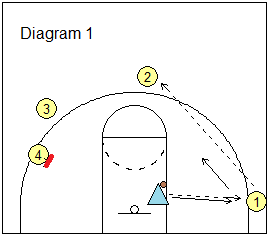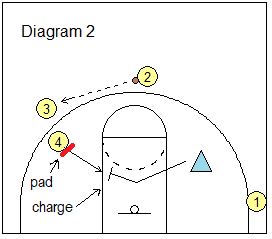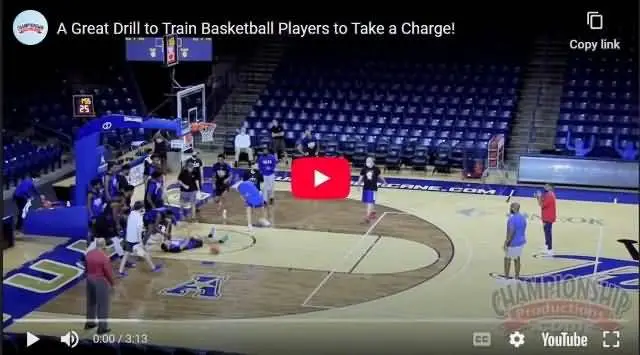Taking The Charge - Tips and Drills
By Dr. James Gels, From the Coach’s Clipboard Basketball Playbook"Helping coaches coach better..."
With today's dribble-drive offenses, in addition to good on-ball and help defense, taking a charge should be an important part of your team's defense against the dribble-drive. Watching the NCAA March Madness, we are seeing many more charges taken than there ever used to be. Coaches are teaching it and players are getting good at it.
Taking a charge is a big play and can be a momentum changer. It results in a defensive stop, a foul, a change in possession, and makes the offensive player think twice before dribble-driving again.
How to effectively and safely take a charge
1. The defender must get into correct position before the offensive player arrives, with both feet planted.
2. At the college/pro level, and for many state high schools as well, the defender taking the charge must have both feet outside (above) the arc under the basket - feet must not touch or be inside the line.
3. The closer the dribble-penetrator, the lower you get. By getting low, when you fall, it's only a short fall to the floor.
4. Hold your forearm strongly across your body. Use your forearm in front of you to absorb the contact.
5. Fall on both cheeks. If you land on one cheek in a sideways manner, it will look like a block to the ref and you'll get the blocking foul.
6. Fall in the direction of the penetration. Again, if you fall sideways, it will look like you were not there and not planted, and you'll get the foul.
7. When you fall, roll on your back and pull your feet up (feet facing upward) so that if the offensive player falls on you, you can absorb the contact with your feet and protect yourself.
8. When you fall, keep your hands up and take the contact with the forearm. Don't fall with your hands behind you, as this can result in a wrist or hand injury.
9. Finally, sell the charge to the ref by exhaling at the point of contact and letting out a groan. But don't "flop" if there is no contact.
10. Since it is a judgement call and the officials do not always call the charge, it is often not wise to take the charge if you are in foul-trouble.
2. At the college/pro level, and for many state high schools as well, the defender taking the charge must have both feet outside (above) the arc under the basket - feet must not touch or be inside the line.
3. The closer the dribble-penetrator, the lower you get. By getting low, when you fall, it's only a short fall to the floor.
4. Hold your forearm strongly across your body. Use your forearm in front of you to absorb the contact.
5. Fall on both cheeks. If you land on one cheek in a sideways manner, it will look like a block to the ref and you'll get the blocking foul.
6. Fall in the direction of the penetration. Again, if you fall sideways, it will look like you were not there and not planted, and you'll get the foul.
7. When you fall, roll on your back and pull your feet up (feet facing upward) so that if the offensive player falls on you, you can absorb the contact with your feet and protect yourself.
8. When you fall, keep your hands up and take the contact with the forearm. Don't fall with your hands behind you, as this can result in a wrist or hand injury.
9. Finally, sell the charge to the ref by exhaling at the point of contact and letting out a groan. But don't "flop" if there is no contact.
10. Since it is a judgement call and the officials do not always call the charge, it is often not wise to take the charge if you are in foul-trouble.
This video shows great quick defensive rotation into taking a charge.


Take the Charge Drill
This defensive drill teaches players how to take the charge.Setup:
(blue = offense, red = defense, yellow = coach or manager).
Defensive player under the basket in helpside against the yellow coach. Place a floor mat under the basket to cushion the fall for the defender. If your rules use a restricted zone (charge arc), make sure the defender is outside the arc.
First player in the blue line dribbles to the hoop for the lay-up. Stress that the offensive player must take it all the way to the hoop and make contact with the defender. The defender steps into the offensive player's lane, plants his/her feet with a wide stance and braces for the contact.For added safety, instead of dribbling in, the offensive player can attack with a blocking pad (no ball).
Teach the defender that when the contact occurs, avoid injury by just "sitting down" on the mat, with the butt making initial contact with the floor, not the back or shoulders. Immediately after the contact, the defensive player pops back up quickly, the offensive player moves to back of the line, and the next blue player drives for the next contact. Have each player defend 3 in a row.

Pointers:
1. Make sure the defensive player gets into correct position before the offensive player arrives.
2. Make sure the feet are planted, and that the defender does not move, turn the hips or shoulders, etc. The only movement should be the backward fall when contact is made. Any other movement may result in a blocking foul instead of a charge.
3. The defender should be vocal and moan when the contact occurs ("OH!!!"). You've got to sell it to the ref.
4. Use an extra manager or assistant under the basket to help catch the offensive player after contact is made, to avoid injury.
Take the Charge Drill #2
This is a good defensive drill from coach Frank Haith with a close-out, defensive positioning, and taking a charge.Diagram 1. Not shown, there is a line of defenders waiting under the basket. The defender (blue) passes the ball out to O1 (coach or manager). The defender closes-out on the ball as O1 holds it briefly. Then O1 passes to O2 and the defender sprints into defensive position up the line. After a brief pause, O2 passes to O3 (diagram 2) and the defender sprints into helpside.
O4 has a blocking pad, and as the defender sprints into helpside, O4 moves in and hits the defender with the blocking pad, as the defender takes the charge. The defender's teammates pick him/her up, with a quick vocal celebration (because it's a big play).


Also see "Charge/Loose-ball Drill"
